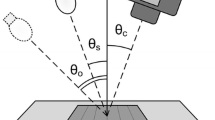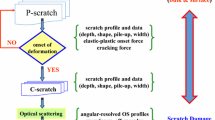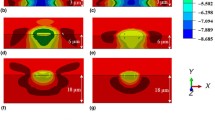Abstract
Current methods for scratch resistance assessment are often based on “relative but not quantitative” types of measurements, such as visual inspection, gloss changes, and changes in gray scale level or lightness. Most results are used for qualitative assessment purposes, which result in the lack of a repeatable and reliable standardized test method for the polymer materials community. To implement a scientifically based standardized test method for quantifying scratch resistance, it is vital to understand the relationships between material mechanical properties, morphology, and appearance (optical properties) of surface and subsurface deformation. In this article, preliminary results from a scratch testing protocol to identify the “onset” of plastic deformation in poly(methyl methacrylate) and poly(propylene) commercial samples are presented. Recent advances in optical scattering measurements to identify the onset of plastic deformation by analyzing specular and off-specular intensities are also presented.
Similar content being viewed by others
References
Betz, P. and Bartelt, A., “Scratch Resistant Clear Coats: Development of New Testing Methods for Improved Coatings,”Prog. Org. Coat., 22, 27–37 (1993).
Shen, W., Ji, C., Jones, F., Everson, M.P., and Ryntz, R.A., “Measurement by Scanning Force Microscopy of the Scratch and Mar Resistance of Surface Coatings,”Surf. Coat. International, 6, 253–256 (1996).
Ryntz, R.A., Abell, B.D., Pollano, G.M., Nguyen, L.H., and Shen, W.C., “Scratch Resistance Behavior of Model Coating Systems,”Journal of Coatings Technology,72, No. 904, 47–53 (2000).
Lin, L., Blackman, G.S., and Matheson, R.R., “Quantitative Characterization of Scratch and Mar Behavior of Polymer Coatings,”Mater. Sci. Eng., A 317, 163–170 (2001).
Jardret, V., Lucas, B.N., Oliver, W., and Ramamurthy, A.C., “Scratch Durability of Automotive Clear Coatings: A Quantitative, Reliable and Robust Methodology,”Journal of Coatings Technology,72, No. 907, 79 (2000).
Ryntz, R.A. and Britz, D., “Scratch Resistance Behavior of Automotive Plastic Coatings,”Journal of Coatings Technology,74, No. 925, 77 (2002).
Krupicka, A., Johansson, M., Wanstrand, O., and Hult, A., “Mechanical Response of Ductile Polymer Coatings to Contact and Tensile Deformation,”Prog. Org. Coat., 48, 1–13 (2003).
Courter, J.L. and Kamenetzky, E.A., “Micro- and Nano-Indentation and Scratching for Evaluating the Mar Resistance of Automotive Clearcoats,”Eur. Coat. J., 7, 24–38 (1999).
Courter, J.L., “Mar Resistance of Automotive Clearcoats: 1. Relationship to Coating Mechanical Properties,”Journal of Coatings Technology,69, No. 866, 57 (1997).
Pangarajan, P., Sinha, M., Watkins, V., Harding, K., and Sparks, J., “Scratch Visibility of Polymers Measured using Optical Imaging,”Mater. Eng. Sci., 43 (3), 749–758 (2003).
Fernholz, K., Sinha, M., Gardner, M., and Watkins, V., “Scratch Visibility: Application of GE’s Visual Quality Method at Ford,”Proc. 7th International Coatings for Plastics Symposium, Troy, MI, June 7–9, 2004.
NIST-Industry Polymer Interphase Consortium (PIC)–more details: visit the PIC consortium website at slp.nist.gov.
VanLangdingham, M.R., Chang, N.K., Wu, T.Y., Sung, L., Jardret, V.D., and Chang, S.H., “Measurement Approaches to Develop a Fundamental Understanding of Scratch and Mar Resistance,”JCT Research,1, No. 4, p 257–266 (2004).
Corle, T.R. and Kino, G.S., “Confocal Scanning Optical Microscopy and Related Imaging Systems” Academic Press 37–39, 1996.
Sung, L., Jasmin, J., Gu, X., Nguyen, T., and Martin, J.W., “Use of Laser Scanning Confocal Microscopy for Characterizing Changes in Film Thickness and Local Surface Morphology of UV-Exposed Polymer Coatings,”JCT Research,1, No. 4, p. 267 (2004).
Sung, L., Garver, J., Embree, E., Dickens, B., and Martin, J.W., “A Novel Light Scattering Instrument for Characterizing Polymer Coatings and Plastics,” in press,Rev. Sci. Instrum. (2005).
Briscoe, B.J., Pelillo, E., and Sinha, S.K., “Scratch Hardness and Deformation Maps for Polycarbonate and Polyethylene,”Polym. Eng. Sci., 36 (24), 2996–3005 (1996).
Jardret, V. and Morel, P., “Viscoelastic Effects on the Scratch Resistance of Polymers: Relationship Between Mechanical Properties and Scratch Properties at Various Temperatures,”Prog. Org. Coat., 48, 322–331 (2003).
VanLangdingham, M.R., “A Review of Instrumented Indentation,”J. Res. NIST, 108 (4), 249–265 (2003).
VanLandingham, M.R., Camara, R., and Villarrubia, J.S., “Measuring Tip Shape for Instrumented Indentation Using Atomic Force Microscopy,” in press,J. Mater. Res (2005).
Author information
Authors and Affiliations
Rights and permissions
About this article
Cite this article
Sung, LP., Drzal, P.L., VanLandingham, M.R. et al. Metrology for characterizing scratch resistance of polymer coatings. J Coat Technol Res 2, 583–589 (2005). https://doi.org/10.1007/BF02774587
Published:
Issue Date:
DOI: https://doi.org/10.1007/BF02774587




